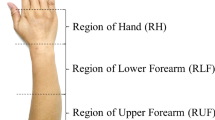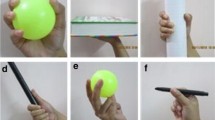Abstract
Applications in pattern recognition and feature extraction for hand tasks are widely applied in prosthesis design through superficial electromyographic signals (sEMG) characterization. Novel applications still require higher classification accuracies and inter-subject invariability. Moreover, as machine learning techniques are implemented in a prosthesis, higher interest is focused on the training data, considering real-life variables as muscle fatigue and continuous data collection. This paper presents the detection of three different grasping action groups using two electrodes positioned in the extensor and flexor digitorum from a benchmark database with acquired real-life signals. Higuchi’s Fractal Dimension feature extraction technique is applied to determine a feature vector as training input data. Consequently, the training algorithm with a Support Vector Machine (SVM) technique for two kernel functions: linear and radial. Results indicate accuracies of 97.2%, 92.2%, 89.7% for two, three, and four task grasping actions with a Radial Basis Function kernel, respectively.
Access this chapter
Tax calculation will be finalised at checkout
Purchases are for personal use only
Similar content being viewed by others
References
Calado A, Soares F, Matos D (2019) A review on commercially available anthropomorphic myoelectric prosthetic hands, pattern-recognition-based microcontrollers and sEMG sensors used for prosthetic control. In: 2019 IEEE International conference on autonomous robot systems and competitions (ICARSC), IEEE, pp 1–6
Iqbal N, Subramaniam K, Asmi S (2018) A review on upper-limb myoelectric prosthetic control. IETE J Res 64(6):740–752. https://doi.org/10.1080/03772063.2017.1381047
Phinyomark A, Quaine F, Charbonnier S, Serviere C, Tarpin-Bernard F, Laurillau Y (2013) EMG feature evaluation for improving myoelectric pattern recognition robustness. Expert Syst Appl 40(12):4832–4840
Atzori M, Gijsberts A, Castellini C, Caputo B, Hager AGM, Elsig S, Giatsidis G, Bassetto F, Müller H (2014) Electromyography data for non-invasive naturally-controlled robotic hand prostheses. Sci Data 1(1):1–13
Zhai X, Jelfs B, Chan RH, Tin C (2016) Short latency hand movement classification based on surface EMG spectrogram with PCA. In: 2016 38th Annual international conference of the IEEE engineering in medicine and biology society (EMBC), IEEE, pp 327–330
Castellini C, Fiorilla AE, Sandini G (2009) Multi-subject/daily-life activity EMG-based control of mechanical hands. J Neuroeng Rehabil 6(1):1–11
Boccia G, Dardanello D, Beretta-Piccoli M, Cescon C, Coratella G, Rinaldo N, Barbero M, Lanza M, Schena F, Rainoldi A (2015) Muscle fiber conduction velocity and fractal dimension of EMG during fatiguing contraction of young and elderly active men. Physiol Meas 37(1):162
Xiao H, Zhi-zhong W, Xiao-mei R (2005) Classification of surface EMG signal with fractal dimension. J Zhejiang Univ Sci B 6(8):844–848
Arjunan SP, Kumar DK, Naik GR (2010) A machine learning based method for classification of fractal features of forearm sEMG using twin support vector machines. In: 2010 Annual international conference of the IEEE engineering in medicine and biology, IEEE, pp 4821–4824
Escandón E, Flores C (2020) Clustering of sEMG signals on real-life activities using fractal dimension and self-organizing maps. In: 2020 IEEE engi-neering international research conference (EIRCON), pp 1–4. https://doi.org/10.1109/EIRCON51178.2020.9253761
Kuzborskij I, Gijsberts A, Caputo B (2012) On the challenge of classifying 52 hand movements from surface electromyography. In: 2012 Annual international conference of the IEEE engineering in medicine and biology society, IEEE, pp 4931–4937
Smith LH, Hargrove LJ, Lock BA, Kuiken TA (2010) Determining the optimal window length for pattern recognition-based myoelectric control: balancing the competing effects of classification error and controller delay. IEEE Trans Neural Syst Rehabil Eng 19(2):186–192
Higuchi T (1988) Approach to an irregular time series on the basis of the fractal theory. Physica D 31(2):277–283
Accardo A, Affinito M, Carrozzi M, Bouquet F (1997) Use of the fractal dimension for the analysis of electroencephalographic time series. Biol Cybern 77(5):339–350
Boser BE, Guyon IM, Vapnik VN (1992) A training algorithm for optimal margin classifiers. In: Proceedings of the fifth annual workshop on computational learning theory, pp 144–152
Ameri A, Kamavuako EN, Scheme EJ, Englehart KB, Parker PA (2014) Support vector regression for improved real-time, simultaneous myoelectric control. IEEE Trans Neural Syst Rehabil Eng 22(6):1198–1209
Chang CC, Lin CJ (2011) LIBSVM: A library for support vector machines. ACM Trans Intell Syst Tech (TIST) 2(3):1–2
Pedregosa F, Varoquaux G, Gramfort A, Michel V, Thirion B, Grisel O, Blondel M, Prettenhofer P, Weiss R, Dubourg V, Vanderplas J, Passos A, Cournapeau D, Brucher M, Perrot M, Duchesnay E (2011) Scikit-learn: machine Learning in Python. J Mach Learn Res 12:2825–2830
Brorsson S (2008) Biomechanical studies of finger extension function. Analysis with a new force measuring device and ultrasound examination in rheumatoid arthritis and healthy muscles. Institute of Clincial Sciences. Department of Orthopaedics
Author information
Authors and Affiliations
Corresponding author
Editor information
Editors and Affiliations
Rights and permissions
Copyright information
© 2021 The Author(s), under exclusive license to Springer Nature Switzerland AG
About this paper
Cite this paper
Escandón, E., Flores, C. (2021). Classification of Daily-Life Grasping Activities sEMG Fractal Dimension. In: Iano, Y., Saotome, O., Kemper, G., Mendes de Seixas, A.C., Gomes de Oliveira, G. (eds) Proceedings of the 6th Brazilian Technology Symposium (BTSym’20). BTSym 2020. Smart Innovation, Systems and Technologies, vol 233. Springer, Cham. https://doi.org/10.1007/978-3-030-75680-2_96
Download citation
DOI: https://doi.org/10.1007/978-3-030-75680-2_96
Published:
Publisher Name: Springer, Cham
Print ISBN: 978-3-030-75679-6
Online ISBN: 978-3-030-75680-2
eBook Packages: EngineeringEngineering (R0)




